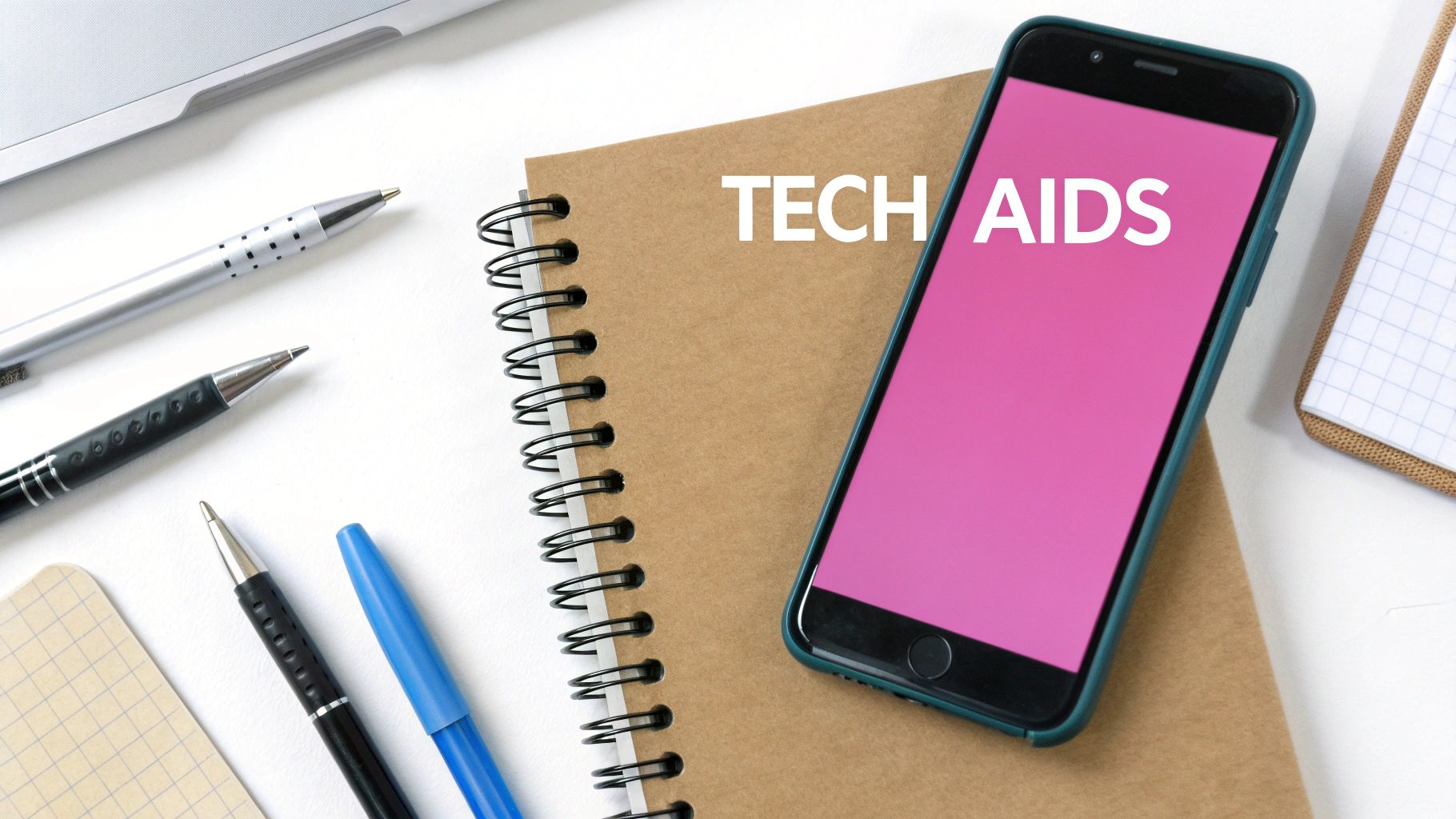
Good Methods to Study: A Practical Guide to Transform Your Learning Journey
The Psychology of Effective Learning

Learning is about much more than just memorizing facts – it’s about building deep understanding that stays with you. When we better understand how our brains process and retain information, we can develop study methods that really work. Simple passive reading often isn’t enough. The most effective learning happens when we actively engage with the material. Let’s explore the science behind why certain study approaches lead to better results than others.
Active Recall: Testing Your Knowledge
Picture yourself trying to learn a new language. You could spend hours reading vocabulary lists over and over. But you’ll learn much more effectively by testing yourself – trying to recall words and their meanings without looking at the answers. This process of active recall strengthens the neural pathways in your brain that store that information. Research shows that testing yourself can improve learning by up to 50% compared to just re-reading material. This approach works especially well for learning concrete facts and information.
Spaced Repetition: Fighting the Forgetting Curve
Think about watering a plant – giving it small amounts of water regularly works better than drowning it once and forgetting about it. The same principle applies to learning. Our brains naturally forget information over time, but we can combat this by reviewing material at carefully spaced intervals. By spacing out study sessions and reviewing just as you’re about to forget something, you help cement that information in your long-term memory. Studies have found that spaced repetition can boost retention by as much as 80% compared to cramming everything at once.
Interleaving: Mixing Up Your Subjects
While it might seem logical to focus on one topic at a time, mixing different subjects together during study sessions can actually improve learning. This technique, called interleaving, helps your brain get better at distinguishing between related concepts. For example, rather than studying all your biology notes followed by all your chemistry notes, try alternating between the two subjects. It’s similar to learning different types of dance – practicing various styles in the same session helps you better understand the unique elements of each one.
Applying These Techniques: A Practical Example
Let’s look at how to put these methods into practice using flashcards as an example. First, write questions on one side and answers on the other. Test yourself by trying to answer before looking at the solution – that’s active recall in action. Next, use spaced repetition by reviewing cards at increasing intervals. You might review new cards daily at first, then every few days, then weekly. Finally, mix up cards from different subjects in each review session to benefit from interleaving. While this approach takes more effort initially, it leads to much better long-term learning and understanding. You’ll move from passive reading to active learning, helping you truly grasp and remember the material.
Making Spaced Repetition Work For You

Spaced repetition stands out as one of the most research-backed methods for effective learning. This technique aligns with how our brains naturally process and store information, helping create lasting knowledge rather than temporary memorization. While Hermann Ebbinghaus’s research clearly showed the limitations of cramming, spaced repetition offers a smarter approach by strategically timing review sessions. Let’s explore how to put this method into practice to get the most from your study time.
Understanding the Core Principles
The key insight behind spaced repetition is simple but powerful – reviewing information right before you’re likely to forget it helps cement it in your memory. Just as muscles grow stronger with regular exercise, your memory strengthens when you repeatedly activate neural pathways at specific intervals. For instance, after learning something new, you might review it the next day, then three days later, then after a week, with gaps gradually increasing as your recall improves.
Building Your Spaced Repetition System
You can implement spaced repetition in several ways depending on what works best for you. Traditional paper flashcards remain effective when used systematically with spaced intervals. For a more automated approach, Anki provides intelligent scheduling of review sessions based on how well you remember each item. This software tracks your performance and adjusts intervals accordingly, ensuring efficient use of study time.
| Method | Description | Benefits |
|---|---|---|
| Physical Flashcards | Handwritten cards with questions on one side and answers on the other. | Portable, tactile learning experience; encourages active recall. |
| Digital Flashcards (Anki) | Software that automates spaced repetition scheduling. | Efficient review scheduling; tracks progress; offers customizable features. |
| Self-Testing | Creating practice quizzes and tests. | Reinforces active recall; identifies knowledge gaps. |
Integrating Spaced Repetition Into Your Routine
Success with spaced repetition requires thoughtful planning and regular practice. Start by breaking your study material into clear, manageable chunks. Next, create flashcards or set up your digital tool to structure your reviews. Make time in your schedule for daily review sessions, even when focusing on new topics. Small, consistent efforts tend to produce better results than occasional long study sessions.
Avoiding Common Pitfalls and Staying Motivated
While spaced repetition can dramatically improve learning outcomes, certain challenges often arise. Missing review sessions is perhaps the biggest obstacle – life gets busy, and it’s easy to skip a day or two. Combat this by linking review sessions to existing habits, like checking flashcards during your morning coffee or commute. Motivation can also wane over time, but tracking your progress helps maintain momentum. Many digital tools provide statistics and graphs showing your improvement, which can keep you engaged and committed. By understanding these basic principles, creating a personalized system, and maintaining consistent practice, you can use spaced repetition to build lasting knowledge in any subject you study.
Transforming Passive Reading Into Active Learning
Learning effectively means shifting from passively absorbing information to actively working with it. When we simply reread notes or highlight text, we often fail to develop a deep understanding of the material. What we need instead are methods that encourage us to engage deeply with what we’re studying. This active approach not only helps us learn and remember better, but also makes studying more interesting and less dull.
Active Recall: The Cornerstone of Effective Study
Active recall is a fundamental learning method that pushes you to pull information from your memory rather than just review it passively. The process works much like building muscle – the more you practice retrieving information, the stronger your ability to remember it becomes. For example, before reviewing your history notes, try writing down everything you can remember about the French Revolution first. This mental effort strengthens the brain’s memory connections, making the information easier to access later. Studies show this technique can improve learning outcomes by up to 50% compared to passive reading.
Practical Techniques for Active Recall
You can incorporate active recall into your study routine in several simple ways. Traditional flashcards remain highly effective – write a question on the front and the answer on the back, then test yourself before checking. The act of retrieving the answer strengthens your memory significantly. Self-testing through practice quizzes or online tools helps identify areas where you need more review. Even explaining concepts out loud to yourself or an imaginary student can serve as a form of active recall practice.
Combining Active Recall With Other Effective Methods
Active recall becomes even more powerful when paired with other proven study techniques like spaced repetition. By spreading out your review sessions and using active recall during each one, you create an especially effective learning system. Consider using chemistry flashcards about the periodic table – review them daily at first, then gradually increase the time between practice sessions while testing yourself each time. You can also mix up different subjects during study sessions through interleaving. For instance, alternate between chemistry flashcards and history notes. This helps your brain make clearer distinctions between related concepts and leads to deeper understanding.
Embrace Active Learning for Long-Term Success
The key shift is moving from passive absorption to active engagement with the material you’re studying. When you embrace methods like active recall, spaced repetition, and interleaving, you’ll not only see better grades but also develop a richer, lasting grasp of what you learn. While this active approach takes more work initially, the long-term benefits make it worthwhile. You’ll move beyond basic memorization and gain the ability to apply your knowledge in meaningful new ways.
Mastering The Art of Information Processing

Learning effectively requires more than just memorizing facts – it’s about developing a deep understanding of the material and being able to use it meaningfully. Top students know that true mastery comes from breaking down complex topics, making connections between ideas, and applying knowledge in practical ways. Let’s explore proven strategies for processing information more effectively to build lasting comprehension.
Deconstructing Complex Topics
When faced with challenging material, the best approach is to break it down into manageable pieces. Think of it like assembling a puzzle – you start by sorting and organizing the pieces before putting them together. For example, when studying biology, begin with basic cell structure before moving on to more complex systems. Starting with foundational concepts gives you a framework to build upon. Take detailed notes on each component, make sure you fully grasp one concept before moving to the next, and gradually work your way up to understanding how everything fits together.
Creating Meaningful Connections
Real learning happens when you can connect different ideas and see how they relate. As you study, actively look for links between concepts, both within the subject and across different areas. For instance, seeing how chemical reactions in cells connect to larger bodily systems helps create a more complete picture. Draw concept maps, explain relationships to others, or write summaries comparing different topics. These activities help cement your understanding by building a web of connected knowledge rather than isolated facts.
Building Long-Term Understanding
The goal is to develop knowledge that sticks with you long-term. While cramming might help you pass a test, it won’t create lasting understanding. Instead, use techniques like regular review sessions spread over time, self-testing through practice problems, and applying concepts to real situations. When studying history, for example, analyze how past events connect to current issues. Working with the material actively and repeatedly helps form strong mental pathways for easier recall later. The key is engaging deeply with the content rather than just reading it passively. Through consistent practice and application, you’ll develop true mastery that serves you well beyond exam day.
Building Your Personal Teaching Framework
True mastery of any subject comes from active engagement, not just passive learning. One of the most effective ways to deeply understand a topic is to learn it as if you were going to teach it to someone else. By thinking like a teacher, you naturally identify gaps in your knowledge and strengthen your grasp of the material. Let’s explore how to create your own teaching framework using proven methods like the Feynman Technique to accelerate your learning.
The Feynman Technique: Simplicity as a Test of Understanding
Named after physicist Richard Feynman, this technique is based on a simple truth: if you can’t explain something in basic terms, you haven’t fully grasped it yet. To use this method, start by writing down everything you know about a topic in plain language, as if explaining it to a beginner. For instance, when studying cellular respiration, explain the process without using technical jargon. This exercise quickly reveals which concepts you understand well and which need more work. The key is using everyday language to break down complex ideas into their basic components.
Explaining Complex Concepts Simply: Analogies and Examples
Good teachers excel at making difficult concepts accessible through clear analogies and real-world examples. When you’re learning something new, try connecting it to familiar ideas. For example, to understand electrical circuits, think about how water flows through pipes – this gives you a concrete way to visualize electron flow. Look for opportunities to link theoretical concepts to practical situations you encounter in daily life. These connections make abstract ideas more tangible and memorable while deepening your understanding.
Testing Your Understanding: The Ultimate Feedback Loop
Teaching serves as an excellent way to test your knowledge. When you try explaining a concept and get stuck, you’ve found a gap in your understanding. This is where the Feynman Technique becomes especially valuable – return to your source material and focus specifically on the areas where you struggled to explain clearly. This targeted approach helps you efficiently fill knowledge gaps rather than reviewing everything. Each attempt to teach reveals new areas for improvement, creating a powerful feedback loop for learning.
Creating Memorable Analogies: A Creative Challenge
Making effective analogies takes practice but gets easier over time. Push yourself to create comparisons that are both clear and engaging. Try developing multiple analogies for the same concept – like examining an object from different angles, this helps build a more complete understanding. For example, you might explain the immune system by comparing it to both a military defense system and a sophisticated security network. This creative process requires you to think deeply about fundamental principles, transforming you from a passive learner into an active creator of knowledge. Through this kind of engaged practice, you develop true mastery rather than just memorizing facts.
Creating Sustainable Study Habits That Last

To get the most out of your study methods, you need to establish habits that can stand the test of time. While cramming might help you pass a single test, developing consistent study practices leads to deeper learning and better long-term results. Just like training for a marathon, steady and strategic effort beats sporadic bursts of intense studying.
Designing Your Ideal Study Environment
Your physical study space directly impacts how well you can focus and learn. Creating a dedicated area free from distractions helps you concentrate better, whether it’s a quiet corner of your bedroom or a spot in the library. Pay attention to practical elements like lighting (natural light helps boost alertness), noise levels, and comfortable seating that supports good posture. Make the space your own by adding personal touches that help you stay motivated, such as inspirational quotes or plants that create a calming atmosphere.
Time Management and Goal Setting for Academic Success
Good study habits require thoughtful planning and organization. Start by creating a realistic schedule that fits with your other activities and commitments. Break larger assignments into smaller, concrete tasks to prevent feeling overwhelmed. When setting goals, be specific – instead of a vague plan to “study biology,” commit to “complete chapter 3 cell biology review in one hour on Tuesday afternoon.” This focused approach makes it easier to track your progress and stay on target.
Maintaining Motivation and Avoiding Burnout
It’s normal for motivation to rise and fall during long study periods. One helpful strategy is to connect your current coursework to your future goals. For medical students, this might mean thinking about how understanding anatomy will help future patients. Taking regular breaks is also essential – try the Pomodoro Technique of 25-minute focused work sessions followed by 5-minute breaks to maintain energy and prevent mental fatigue. Remember to schedule activities you enjoy to keep a healthy balance.
Tracking Progress and Adapting Your Approach
Keeping track of your study sessions and results provides valuable insights for improving your methods. Use a simple system like a planner, spreadsheet, or app to record your study time, completed tasks, and test scores. This information helps identify which techniques work best for different subjects. For example, you might discover that active recall helps you remember historical dates, while practice problems work better for math concepts. Be willing to adjust your approach based on what the evidence shows works best for you.
Ready to make your study sessions more effective? Notescast helps you transform your study materials into engaging videos using AI technology. Instead of just reading text repeatedly, create dynamic learning content that improves understanding and retention. Check out Notescast now and unlock a new era of studying!
